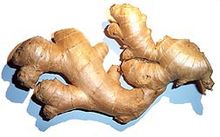Traditional Chinese medicine
Traditional Chinese medicine (also known as TCM) includes a range of traditional medical practices originating in China that has developed over several thousand years. TCM practices include theories, diagnosis and treatments such as herbal medicine, acupuncture, moxibustion and massage; often qigong is also strongly affiliated with TCM. TCM is a form of so-called Oriental medicine, which includes other traditional East Asian medical systems such as traditional Japanese and Korean medicine.
Sourced
[edit]
- Garlic is a lucky plant; it is an antidote to poisons of all sorts. It plays considerable part in the festival of the 5th day of the 5th (Chinese) month. Garlic may also symbolise a rich progeny.
...
Ginger is an important ingredient in many Chinese dishes. Confucius, we are told in the Analects, was 'never without ginger when he ate'. The elaborate system of correspondences which underlies so much Chinese thought required that sauces be prepared according to season with ginger, vinegar, wine or salt. Only honey was invariably included: 'since what is sweet corresponds to the earth which lies in the centre' (Marcel Granet).Since the ginger root often resembles a finger, women were told to keep off ginger during pregnancy, as the child might be born with more than five fingers.
...
Nowadays, ginseng is in great demand as a tonic to which all sorts of curative and restorative properties are attributed. In ancient times, the plant was mainly produced in the mountainous regions of what is today the province of Shanxi, in North China...The roots of the ginseng plant are fairly long and often look like a small child. It is said that ginseng not only looks like a child but can also cry like one.
At the present time, it is mainly in Manchuria and Korea that ginseng is produced. According to an old legend, it was beetle that brought a red child (i.e. ginseng) to Manchuria. There is a well known folk-tale about a man who is offered ginseng to eat; he refuses to eat it, believing it to be a boiled child.
...
Doctors in ancient China who prescribed medicines made from herbal matter or from parts of animals, were divided into three categories: at the top were the state doctors, upper-class men who, in addition to their training in traditional medicine, had studied the medical texts available and had passed a state examination. They were called ‘Great Doctors’, held state posts and were summoned to court if the Emperor or one of his high officials were ill. The second group also belonged to the upper class: they were state officials who had studied medicine as a sideline in their free time. Should a friend or relation fall ill they would do what they could to help. They never asked for payment but expected gifts on suitable occasions such as major feast days or holidays.The third category was drawn from the lower classes of society. Its members were often the sons or grandsons of doctors. Practitioners belonging to this category often had their own private books of remedies and treatments, which were carefully guarded from rival eyes. They worked in small shops or on the streets, and they took payment for their services.
- Wolfram Eberhard - A Dictionary of Chinese Symbols: Hidden Symbols in Chinese Life and Thought, 1986

- Blue whales are known to live one hundred years and more. For animals of their size, seals and dolphins also enjoy a long lifespan. The giant turtle has become legendary as to its longevity. Turtles also hold the record in being able to remain over eight hours without breathing.
These amazing abilities shared by all diving animals could not have remained unnoticed by the Taoists since they were keen observers of nature. Needham, in his monumental work on science in ancient China, describes the Taoists as the first scientists in human history, who carefully noted down their observations and elaborated theories and methods based on such observations.
Considering that pearl diving, which started many thousands of years ago in China, was an additional incentive for Chinese to try to imitate nature, it becomes then evident how Taoists related longevity to the capacity to control and stop breathing.
...
The Five Viscera:1. The heart, corresponding to fire
2. The lungs, corresponding to metal
3. The liver, corresponding to wood
4. The kidneys, corresponding to water
5. The spleen, corresponding to earth
...
The Seven Injuries:1. Over-fullness injures the spleen
2. Great rage injures the liver
3. Fatigue and dampness injure the kidneys
4. Cold food or drink injure the lungs
5. Grief injures the heart
6. Storms and extreme climate injure the body
7. Fear and indulgence injure the will.- Jane Huang - The Primordial Breath, Vol. 1, 1987

- Chinese medicine, like many other Chinese sciences, defines data on the basis of the inductive and synthetic mode of cognition. Inductivity corresponds to a logical link between two effective positions existing at the same time in different places in space. (Conversely, causality is the logical link between two effective positions given at different times at the same place in space.) In other words, effects based on on positions that are separate in space yet simultaneous in time are mutually inductive and thus are called inductive effects. In Western science prior to the development of electrodynamics and nuclear physics (which are founded essentially on inductivity), the inductive nexus was limited to subordinate uses in protosciences such as astrology. Now Western man, as a consequence of two thousand years of intellectual tradition, persists in the habit of making causal connections first and inductive links, if at all, only as an afterthought. This habit must still be considered the biggest obstacle to an adequate appreciation of Chinese science in general and Chinese medicine in particular. Given such different cognitive bases, many of the apparent similarities between traditional Chinese and European science which attract the attention of positivists turn out to be spurious.
...
In therapeutic disciplines such as acupuncture, moxibustion, or massage, three kinds of sensitive points are of interest. By distinguishing among them, we incidentally catch a glimpse of the evolutive stages of foraminology. the first kind are the foramina ad hoc. In Chinese these are called ah-shih-hsüeh because the patient exclaims "oh yes!" (ah shih) when one of these foramina is pressed in exploratory palpation. These ad hoc points, without scientific names or precise topology, are partly identical with the "knots" that masseurs of all civilizations work to dispel.- Manfred Porkert - The Theoretical Foundations of Chinese Medicine: Systems of Correspondence, 1974.
- Well, acupuncture depends entirely on the flow of qi. The acupuncturist senses and directs qi through the needle. Acupuncture without qi is only as effective as one man's sticking needles into the flesh of another. This would serve no purpose. Chinese massage is the same. Qi can be used to heal in many situations. It has been used therapeutically for thousands of years and is basic to all of Chinese medicine. Let me assure you, it is a physical reality.
- Ren Ying-qiu, senior professor at the Beijing Institute of Traditional Chinese Medicine - in David Eisenberg M.D.'s Encounters with Qi: Exploring Chinese Medicine, 1985.
- There is hardly a field in all of historical scholarship of which we know so little as the development Chinese medical thought. A mountain of books which treat this subject has accumulated in the West since the sixteenth century. Some are written by European practitioners, since acupuncture is now a flourishing enterprise in the Occident, and some by scholars. But most of these writings, regardless of origin, obscure rather than illuminate the beautiful Chinese theoretical system.
- Nathan Sivin - in the foreword to Manfred Porkert’s The Theoretical Foundations of Chinese Medicine: Systems of Correspondence, 1974.
- The origins of inoculation against smallpox in China are somewhat mysterious. We know that the technique originated in the southern province of Szechuan. In the south-west of that province there is a famous mountain called O Mei Shan which is known for its connections with both Buddhism and the native Chinese religion of Taoism. The Taoist alchemists who lived as hermits in the caves of that mountain possessed the secret of smallpox inoculation in the 10th century AD. How long before that they had it we shall never know.
- Robert Temple - The Genius of China: 3,000 Years of Science, Discovery and Invention, 1986.

- The ultimate goal of Buddhism – the termination of existential suffering for every individual – invites comparisons with the objectives of medicine. Buddha is frequently termed the ‘King of Physicians’, the only possessor of the true remedy for the eternal cure of illness.
- Paul Ulrich Unschuld - Medicine in China: A History of Ideas, 1985.
- This illness resembles injuries caused by the influence of cold, and yet is the result of something totally different. Cold-related afflictions enter the body through the ends of the hair, and from there reach the blood channels. They continue to penetrate further into the body, eventually entering the conduits. From the yang region they invade the yin region and drive deeper and deeper into the body. Epidemics due to warmth enter the body through the mouth and nose, finally settling on the diaphragm. The affliction is thus located between inner and outer regions and can subsequently manifest itself in nine-fold form.
- Wu Yu-hsing (Wu Yuxing) describing his notably successful treatment of a widespread epidemic which took place between the years 1641 and 1644 across several Chinese provinces - quoted by Unschuld in Medicine in China: A History of Ideas, 1985.
See also
[edit]External links
[edit]- Chinese Medicine Formulae Images Database School of Chinese Medicine, Hong Kong Baptist University. (in English and Chinese)
- Chinese Medicinal Material Images Database School of Chinese Medicine, Hong Kong Baptist University. (in English and Chinese)
- Medicinal Plant Images Database School of Chinese Medicine, Hong Kong Baptist University. (in English and Chinese)
- Phytochemical Images Database School of Chinese Medicine, Hong Kong Baptist University. (in English and Chinese)
- Chinese Medicine Specimen Database School of Chinese Medicine, Hong Kong Baptist University. (in English and Chinese)

